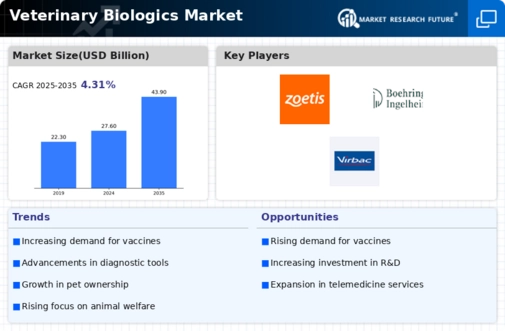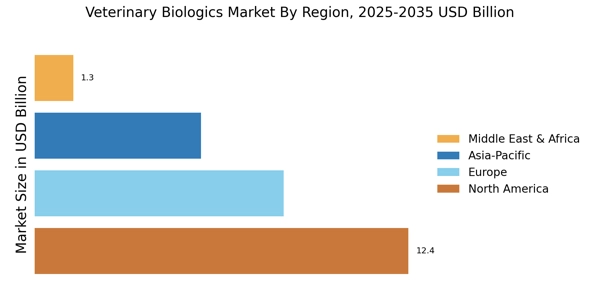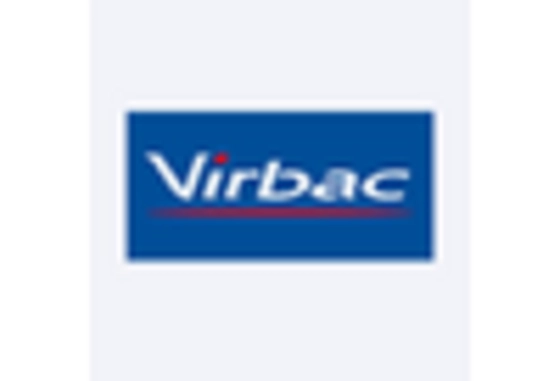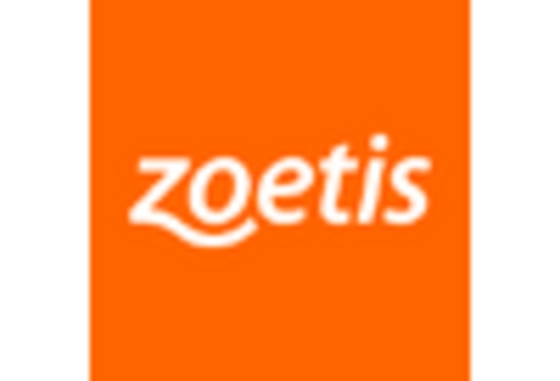The Veterinary Biologics Market is currently characterized by a dynamic competitive landscape, driven by increasing demand for animal health products and a growing focus on preventive care. Key players such as Zoetis (US), Merck Animal Health (US), and Boehringer Ingelheim (DE) are strategically positioned to leverage innovation and expand their product portfolios. Zoetis (US) emphasizes research and development, particularly in vaccines and diagnostics, while Merck Animal Health (US) focuses on enhancing its global footprint through strategic partnerships and acquisitions. Boehringer Ingelheim (DE) appears to prioritize sustainability and digital transformation, integrating advanced technologies into its operations. Collectively, these strategies not only enhance their competitive edge but also shape the overall market dynamics, fostering a climate of innovation and collaboration.
In terms of business tactics, companies are increasingly localizing manufacturing and optimizing supply chains to enhance efficiency and responsiveness to market demands. The Veterinary Biologics Market is moderately fragmented, with a mix of large multinational corporations and smaller specialized firms. This structure allows for diverse offerings and competitive pricing, yet the influence of key players remains substantial, as they set industry standards and drive technological advancements.
In August 2025, Zoetis (US) announced the launch of a novel vaccine targeting a prevalent infectious disease in livestock, which is expected to significantly enhance animal health outcomes. This strategic move not only reinforces Zoetis's commitment to innovation but also positions the company to capture a larger market share in the livestock sector. The introduction of this vaccine is likely to address critical health challenges faced by farmers, thereby strengthening Zoetis's reputation as a leader in veterinary biologics.
In September 2025, Merck Animal Health (US) expanded its collaboration with a leading biotechnology firm to develop next-generation biologics aimed at improving animal welfare. This partnership underscores Merck's strategy to integrate cutting-edge technology into its product development pipeline. By focusing on welfare-enhancing solutions, Merck is not only responding to consumer demands but also aligning with global trends towards more humane animal treatment, which could enhance its market position.
In July 2025, Boehringer Ingelheim (DE) launched a digital platform designed to streamline veterinary practices and improve client engagement. This initiative reflects the company's commitment to digital transformation and its recognition of the growing importance of technology in veterinary care. By enhancing connectivity between veterinarians and pet owners, Boehringer Ingelheim is likely to foster loyalty and improve service delivery, thereby gaining a competitive advantage in the market.
As of October 2025, the Veterinary Biologics Market is witnessing trends such as digitalization, sustainability, and the integration of artificial intelligence into product development and customer engagement strategies. Strategic alliances are increasingly shaping the competitive landscape, enabling companies to pool resources and expertise. Looking ahead, competitive differentiation is expected to evolve, with a shift from traditional price-based competition towards innovation, technological advancements, and supply chain reliability. This transition may redefine market dynamics, compelling companies to invest in research and development to maintain their competitive edge.


















Leave a Comment